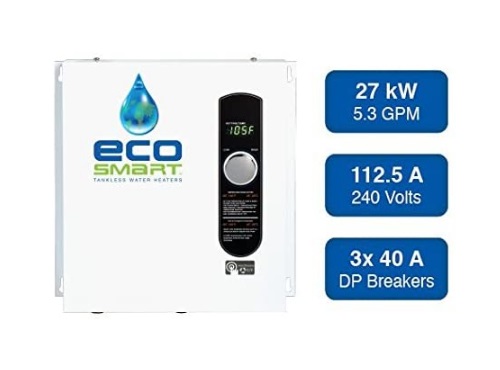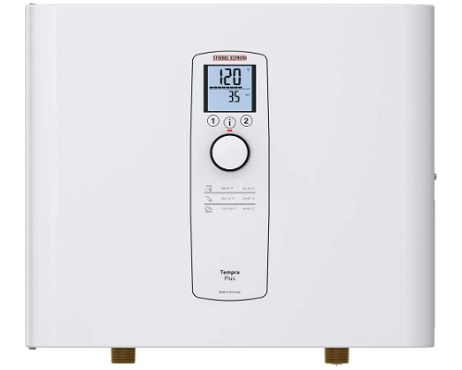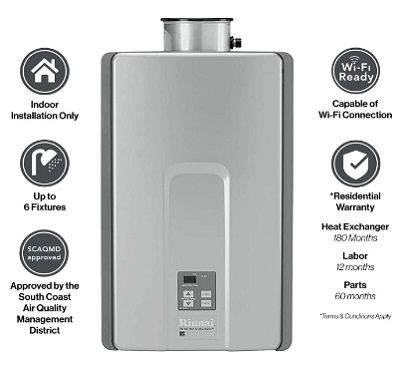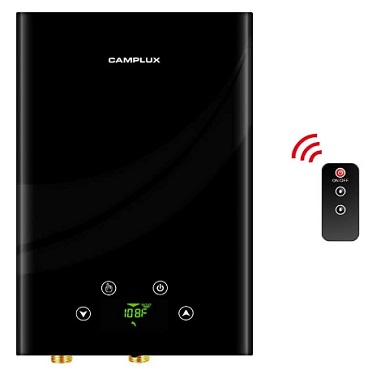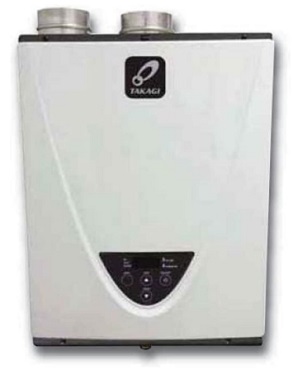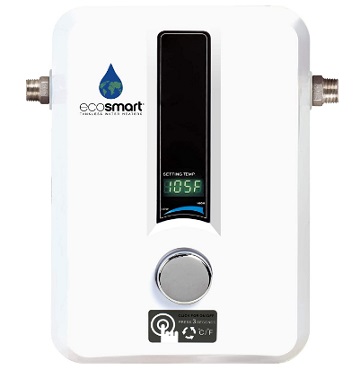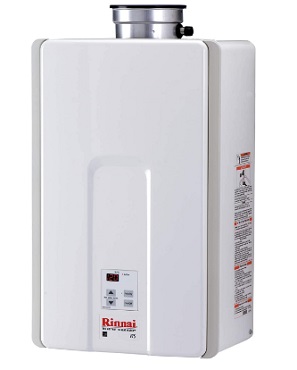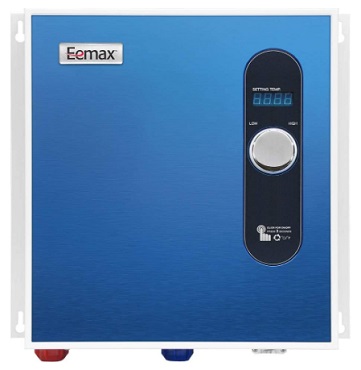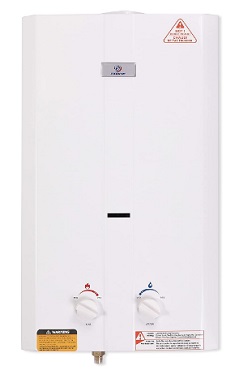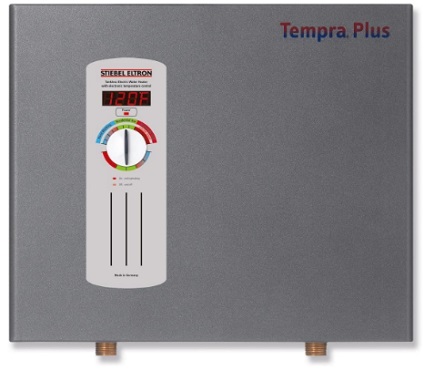In the USA, an average household spends $400-$600 annually and about 14% to 18% of the total utility bill is spent on water heating. The household water heaters consume huge amounts of energy to supply hot water of constant temperature when the faucet is opened. We are also not very careful when we are using the shower. Small things like spending the extra two minutes in the shower, leaving the water running while washing dishes, or washing clothes on hot water instead of cold might add up to a huge amount of energy consumption bill. Similarly, small initiatives like setting the temperature low will save $36-$61 of standby heat loss. Besides, you will be able to retain the demand charge of $400. So, it’s no surprise it’s a hot topic to discuss whether you should install an energy-efficient tankless water heater and save a significant amount of cash in the end.
Tankless water heater is basically the same as a tank water heater, the only difference is that a tankless water heater doesn’t have a tank to store hot water. It is also called an on-demand water heater since it is activated when a faucet is opened and heats up the water at that instant. The tankless water heater can be classified further into two categories: point-of-use tankless water heater and whole-house tankless water heater. Normally, a point-of-use water heater is relatively small and it is installed inside a sink cabinet or in a closet. It is relatively less expensive which is generally dedicated to a single faucet or shower. The point-of-use water heater is not capable of handling multiple devices at a time.
On the other hand, A whole-house tankless water heater is capable of handling the demand for more than one fixture at a time. For instance, a single whole-house unit is sufficient for two shower fixtures, or a dishwasher, kitchen sink, and lavatory hot water faucet simultaneously. But the size and number of whole-house tankless water heaters are subjected to flow rate which again depends on the number and types of fixtures you may have running at one time. So, you might need multiple whole-house tankless water heaters for optimum performance for your resident.
How Long do Tankless Water Heaters Last
Gas burning tankless water heaters will last for over 20 years or more, two or three times longer than tank-type heaters. But the electric models have somewhat shorter life spans like 7 to 10 years. However, this issue is rather dependent on some factors like operating conditions and whether the periodic maintenance is performed duly. The tankless water heaters have affordable and accessible parts that can be replaced easily in case of failure. So, the service life is extended many times.
Top 10 Best Affordable Price Tankless Water Heater
1. EcoSmart ECO 27 Electric Tankless Water Heater
EcoSmart ECO 27 is designed to be one of the most powerful heaters and to handle on-demand water heating in even the coldest climates. It is a whole-house type tankless water heater that is capable of running several fixtures at once in a larger household in warm climates. The ECO 27 has compact sizes and it can save up to 12 cubic feet of storage space. The dimensions are 17H x 17W x 3.625D inches. Depending on the inlet water temperature, this heater can supply between 2.7 and 6.5 gallons-per-minute and the electrical energy consumption is 27 KW.
The most advanced self-modulating technology utilizes only the exact amount of energy needed to heat water when you open a faucet. Hence, it can save up to 50% of the water heating energy cost. ECO 27 has very little waiting time and supplies warm water instantly. Precision digital temperature control allows fine control of 1-degree increments of water temperature. The heater incorporates copper and stainless components for durability and efficiency. These parts are easily replaceable on site.
- High flow rate.
- Compact design.
- Patented technology for maximum efficiency (98%).
- Digital temperature control.
- Poor customer service.
2. Stiebel Eltron Electric Tankless Water Heater
German engineering has made the Stiebel Eltron’s Tempra heater one of the toughest competitors in the market and it has set the highest standards for comfort and reliability. This particular heater features a patented advanced flow control system that automatically reduces the water flow when the demand exceeds the rated capacity of the heater. So, it is guaranteed that hot showers will not be interrupted again. The heater doesn’t require venting and Its small, sleek white design saves space yet still provides endless hot water for your whole house.
Stiebel Eltron Tempra 24 plus requires 24kW, 240V/208V, and recommended household electric service of 150 A. It can deliver water of 86˚ to 140˚F. The temperature of the output water is controlled by a digital system and an LCD display shows the temperature and how much you save on energy costs. This model saves energy with auto-modulation and has the ability to electronically measure water flow. Tempra 24 plus is activated by a minimum water flow of 0.37 GPM and it will maintain a flow of 2.6 GPM at 42˚F.
- Precision German engineered water heater.
- Advance patented flow control technologies.
- Displays utility cost saved by the unit.(98%).
- A digital temperature control system.
- Noiseless heater.
- Extravagant water heater.
- The warranty of the unit is only valid if it is installed by a professional tradesperson.
3. Rinnai RL Series HE+ RL94IN Tankless Water Heater
High efficient Rinnai RL model of tankless water heater saves up to 40% of energy cost and cuts carbon emission as well. Depending on the ground temperature, the RL94IN has a flow rate of 9.4 GPM. This is quite an advanced model featuring optional Wi-Fi monitoring and recirculation technology for faster hot water delivery. The ThermaCirc360 technology recirculates hot water through your pipes to deliver hot water quickly and saves an average of 8,700 bottles of water which is wasted by an ordinary heater when someone is waiting for water to travel from the old tank to your shower.
RL94IN is gas operated indoor type tankless water heater which has an average life expectancy of 20 years. It features a compact design that is only the size of a small suitcase allowing for installation in non-traditional spaces such as the attic, crawls space, or even a closet, and saves 16 sq. feet of space. All the parts of this tankless water heater are replaceable which allows the user to easily swap the damaged ones.
- High flow rate.
- Recirculating technology saves water.
- Wi-Fi connectivity.
- 20 years life expectancy.
- Compact design.
- Poor customer service.
4. Camplux Electric Tankless Water Heater
The Camplux on-demand water heater TE27 is a 27kW point-of-use heating system that offers you instant, endless, and consistent temperature hot water in 24 hours of 7 days. The stylish modern outlook features an In-Mold panel which makes the heater suitable for home, office, or salon as it blends in any location. The cutting edge touch display and remote control help you to adjust the output water temperature with ±1 degree accuracy and you can switch between the Fahrenheit scale to centigrade scale easily. Standard ¾ NPT male fittings of the heater make it compatible with most of the faucets and showers. A TE27 water heater is ETL and NSF approved offering you lead-free water quality, excellent performance, and safety.
The heater is fashioned with stainless steel components for high efficiency and durability. Camplux Electric TE27 on-demand electric water heater will only draw the amount of electricity required to produce the hot water and avoids pre-heating to save energy and heat up the water in seconds. It requires 240 volts and 27 KW of electrical power or up to 87,500 BTU and the heater can get water between 86°F – 125°F with a maximum inlet pressure of 145 psi. It’s a solid functioning heater with multiple protection to ensure safety.
- Affordable.
- Easy and less expensive to install.
- Multiple safety measures.
- Remote control.
- A stylish and sleek water heater which can be mount at any angle.
- The large electrical load may interfere with other household devices.
5. Takagi T-H3-DV-N Tankless Water Heater
T-H3-DV-N is well designed for both commercial and domestic applications. It’s a natural gas operated on-demand water heater that complies with the 2012 SCAQMD Rule 1146.2 for Ultra-Low NOx regulations. This unit is less expensive than the other candidates and it’s ideal for someone who requires a 10 GPM flow rate at 100°-185° temperature. The energy star certified Takagi T-H3-DV-N heater needs an extra power supply of 120 volts in addition to a 199,000 BTU energy input from a gas burner.
This tankless water heater is designed for indoor operation only and it’s quite given the noise level of 55dB. The dimensions of the model are 10.75 x 17.75 x 22.5 inches which are fairly compact and can be installed in a beauty salon or a small restaurant. For safety, the T-H3-DV-N model features an air-fuel ratio sensor, exhaust, and water temperature safety control, an overheat cutoff fuse. One standalone unit can be manifold to 4 additional heaters using Easy-link for added capacity. The primary heat exchanger utilizes commercial grade copper which is corrosion resistant and bears a warranty of 15 years in case of residential application.
- Economic gas operated tankless water heater.
- Low NOx emission.
- Noiseless.
- Slim design.
- High flow rate.
- It requires a dedicated gas line which increases the installation cost.
6. EcoSmart ECO 11 Electric Tankless Water Heater
EcoSmart ECO 11 is a 13-kilowatt on-demand electric water heater ideal for supplying hot water for a bathroom, small sink, office breakroom, and other point-of-use or low-flow applications. The flow rate of this model is 1.3 to 3.1 GPM depending on the water temperature to support low profile users. The ECO 11 saves up to 60% of the electricity bill required for hot water because of the patented Self Modulating Technology and design. The slim contour of the heater saves installation space.
The ECO 11 utilizes electricity of 13,000 KW of 220 volts from a 125 amp electrical panel to heat up a low inlet water temperature of 67°F to an output setting of 105°F maintaining a flow rate of 2 GPM. With the help of the digital temperature control system, the outlet water temperature can be adjusted up to 1°F precision within a range of 80 – 140° F. The heater starts its operation with a 0.3 GPM flow. The components of the heater are field replaceable.
- Electric heater unit which quite easy and cheap to install.
- Field replaceable parts.
- Energy efficient on-demand heater.
- Compact size.
- Digital control.
- Claiming a warranty can be problematic sometimes.
7. Rinnai V75iP Tankless Hot Water Heater
V75iP is the impeccable combination of high efficiency, comfort, and value in a propane gas tankless water heater from Rinnai. It runs on propane gas or natural gas which is ideal for small to medium homes or remodels and mobile. The V75iP model from Rinnai comes with a uniform energy factor of 0.81 which requires 40% less energy than the traditional heaters.
The rated flow rate of this heater ranges from 0.26 – 7.5 GPM and energy consumption is 180,000 BTU. The control system requires an electrical power supply of AC 120 volt. The noise level of this model is 55 dB. The NOx emission level of the gas burner of the heater is 14 ng/J or 20 ppm. V75iP features boiling protection, flame failure-flame rod, combustion fan rpm check, thermal, and automatic freeze protection for safety. It has Wi-Fi connectivity and the average life expectancy of the unit is 20 years.
- Energy-saving gas-fired water heater.
- Low nitrous oxide emission.
- Low noise level.
- High flow rate.
- Wi-Fi connectivity.
- High installation cost.
- Requires both gas and electricity supply.
8. Eemax EEM24027 Electric Tankless Water Heater
The EEM24027 is designed to produce enough hot water for up to 1 shower and 2 sinks simultaneously in colder climates where it can supply 4 showers or sinks in warmer weather. To be precise, it can provide 3.2 GPM at a temperature of 47°F and 6.6 GPM at 77°F. It runs on electricity and requires 27 KW of electricity at a voltage level of 220 volts. It would draw 112.5 ampere current. EEM24027 from Eemax features the most advanced self-modulating technology which adjusts how much energy needs to be input based on how much hot water is needed. It has an energy efficiency of 99.8%.
This on-demand whole-house type water heater utilizes enameled steel rated cover and standard Emerson copper heating elements with threaded brass top with 1/2” plumbing connections for easy flex hose connection. Also, there is a replaceable inlet mesh filter and the heat exchanger is made of stainless steel.
- Compact electric water heater.
- Easy to install.
- High energy efficiency.
- Easy to connect to a water hose.
- Not suitable for the bathtub.
9. Eccotemp L10 2.6 GPM Portable Tankless Water Heater
Founded in 2004, Eccotemp is a family owned manufacturer of energy efficient devices which is located outside of Charleston, in Summerville, SC. The L10 water heater from Eccotemp is a portable device and its ignition system is powered by D cell batteries which require no AC power connection and pilot light. It utilizes liquid propane only and is capable of delivering 2 to 2.65 gallons of hot water almost anywhere. It produces 75,000 BTU/h and is activated by 25 psi gas pressure and water controlled auto ignition with water pressure between 20-80 psi.
Since it’s a portable device intended for outdoor use, it is fashioned with a stainless steel rain cover and anti-dry combustion protection which shut off the gas supply in the event water stops flowing through the portable tankless water heater. It has a removable drain valve to avoid water pipe and regulator damage caused by freezing water. The water pressure and temperature can be adjusted using manual control. To prevent fire hazards, it employs over-pressure overheating and flameout protection.
- Since it’s a portable unit, virtually no installation is required.
- No pilot light.
- Autoignition controlled by water pressure.
- Protection schemes.
- Energy efficient gas-powered water heater.
- It can operate at an elevation of 5,500 ft.
- Not very durable.
10. Stiebel Eltron Tempra Plus 29 kW, tankless electric water heater
Stiebel Eltron Tempra 29 plus electric tankless water heater is one of the most technologically advanced tankless water heaters available on the market. It is redesigned completely utilizing upgraded heavy-duty electronics, a simple single flow sensor design, a hinged cover for easy access, and advanced flow control. It is a fine example of German engineering and precision. Tempra 29 plus is less expensive than gas-operated heaters and the installation cost is also lower and simpler because it doesn’t require venting the exhaust to the outside.
To heat up the water, Tempra Plus needs electrical power of 28.8 KW from a source of 208 volts and min. 200A AC 3 phase service line and maintains a flow rate of 3.1 GPM when the inlet water temperature is 42°F. Because of exclusive advanced flow control technology, the heater adjusts the outlet water pressure to maintain a consistent temperature. For plumbing, the Tempra Plus features ¾ NPT outlets. It can save 15-20% of the electricity bill for hot water.
- Consistent output.
- Energy efficient.
- An electrical water heater requires a minimum installation cost.
- A digital temperature control system.
- Some user complained about the temperature fluctuation.
Key Consideration Before Tankless Water Heater
Water heating is the second largest utility expanse of an average household. The impact on the environment is also enormous because of the vast energy consumption of these water heaters and the carbon emission caused by that energy production. An energy efficient water heater not only saves the utility bills but also entitles the consumer to a tax credit. For that, the homeowner must have a water heater with an energy factor of 0.82.
Apart from energy efficiency, there are several key factors the buyer has to consider before buying a tankless water heater:
Fuel type
A household tankless water heater is fueled by three types of energy sources such as propane gas, natural gas, and electricity. Natural gas is the cheapest among them when you have a pre-existing gas line. But natural gas is difficult to store and if you don’t have a gas line, installing a new one can be prohibitively expensive. Propane gas is available in canisters and it is more practical for use in a mobile home or recreational vehicle rather than home use because of cost. The propane gas tank is usually fitted near the water heater.
Electrical models of tankless water heaters consume high energy and hence the cost of electricity bill must be considered over the initial low cost of these types of heaters
Types of the tankless heater (point-of-use or whole-house):
Another important issue is to choose between point-of-use or whole-house type tankless water. If you happen to have only a single fixture then point-of-use tankless water heaters are a viable option. These devices are fitted near the faucet which reduces the length of cold water sitting in the pipes so it is able to provide hot water faster while minimizing the water down the drain. But it’s not always practical since a house has multiple fixtures to supply hot water and a whole-house water heater is required in such conditions.
Flow rate
This parameter informs the maximum volume of hot water that the tank is capable of producing and it is measured in gallon per minute (GPM) units. Each fixture requires a certain amount of GPM to perform as expected. For instance, a shower uses approximately 3 GPM, while a tub uses about 4 GPM. The flow rate determines the size, capacity, and number of tankless water heaters.
Condensing vs. Non-condensing
When the water heaters heat up the water, steam is produced as a byproduct. Non-condensing tankless water heaters vent that steam directly. As a result, a large amount of heat is lost which in turn reduces the total efficiency of the heater by 15-20%. The condensing tankless water heaters utilize a condensing unit that captures the residual exhaust heat before releasing a much cooler exhaust through ventilation channels to the outside. Obviously, they have higher thermal efficiency than their counterparts which is up to 95%. But they are more expensive than non-condensing water heaters.
Venting
Gas operated water heaters produce exhaust that must be vented outside of the home, away from doors, windows, or any area easily accessible by the home dwellers. Hence, the installation cost is increased and it will vary depending on the situation. Besides, noncondensing water heaters emit exhaust at high temperatures and hence they use stainless-steel vents that can withstand high exhaust heat. As a result, installation cost gets higher. The condensing type heaters use less expensive PVC pipes as they have a relatively cooler exhaust. A concentric vent simplifies the installation since it has an exhaust pipe inside a larger air-intake pipe.
Power input (BTU)
The required energy for tankless water heaters is expressed in BTU (British Thermal Unit) and it refers to the amount of energy needed to raise the temperature of one pound of water by one degree Fahrenheit. To calculate the BTU unit, the formula would be: required BTU = ((500 x GPM x temperature change) / efficiency in percent)
Energy factor
The energy factor of a water heater expresses the efficiency of the device based on the amount of hot water produced per unit of fuel consumed over a typical day. The energy factor is evaluated by recovery efficiency, standby losses, and cycling losses. The product brochure from the manufacturer normally provides a water heater model’s energy factor. Usually, the higher the energy factor, the more efficient the device is. But sometimes higher energy factor values don’t always mean lower annual operating costs because of fuel sources. You can estimate the annual operating cost by energy factor and fuel cost and find out the payback time of a particular water heater compared with other models.
Cost
The more efficient models may cost more initially but if you compare the operating cost with less expensive inefficient heaters, you will see that the inefficient heaters will cost you more every year. By calculating operating cost using energy factor and fuel cost you can compare two models and estimate the payback time of the high efficient model in terms of the fuel cost savings.
User friendly
Water heaters featuring digital displays and only a few control buttons are easy to operate and a wise choice for a homeowner. Some heaters employ an autoregulation mechanism that is also easily accessible for the user. Overcomplicated control, mechanisms can be troublesome and confusing.
Water hardness
limescale deposition due to the hardness of water will reduce the heat exchange rate and flow of water from the heater. Once the hardness exceeds 120 milligrams per liter, you should consider investing in water treatment. Because, every time you need to flush the pipes, you have to call plumbers and it may cost around $300. Point-of-use TAC-Ler water conditioner cartridges alter hardness without utilizing salt or other chemicals.
What Are The Advantages And Disadvantages Of A Tankless Water Heater?
The tankless water heater is a superstar of water heaters because of energy efficiency and other cutting edge technologies like Wi-Fi connectivity. Because of environmental concerns and higher electricity bills, it is justified to replace your old tank type water heater.
Tankless water heaters can avoid the standby heat losses associated with storage water heaters. However, there are several disadvantages associated with these types of heaters. Here are some advantages and disadvantages of tankless water heaters:
Advantages
- These units heat water on demand meaning they start operation only when you turn on a fixture.
- These heaters usually operate on electricity, natural gas, or propane.
- They eliminate the extra cost of keeping 40 to 50 gallons of water hot in a storage tank, so you waste less energy.
- These heaters are capable of continuously supplying hot water, which is ideal for filling a big hot tub or a whirlpool.
- Tankless heaters are more compact than a standard water heater and mount on a wall
- The tankless water heaters will typically last longer and have lower operating and energy costs than a standard water heater. They also have easily replaceable parts which extend their life by several years further.
Disadvantages
- The high price and the upfront cost is a major setback for tankless water heaters
- The point-of-use tankless water heaters cannot support multiple water outlets simultaneously.
- Depending on the groundwater temperature of your locality and household demand, you might need multiple units of the whole-house tankless water heater.
- Although gas-fired tankless water heaters tend to have higher flow rates than electric ones, there is a chance that they may waste energy if they are equipped with a constantly burning pilot light.
Frequently Asked Questions (FAQ)
How much is the installation of a tankless water heater?
The national average installation cost of tankless water heaters would be around $2,500 – $4,500. This cost depends on the region you are living in and the model of the heater. The point-of-use water heaters are installed close to the water source and are fairly inexpensive to purchase and install. The whole-house units are costly and expensive to install.
Is a worth it?
This issue is subject to arguments. The tankless heaters have evolved into a sophisticated device and include features like built-in recirculating pumps (for “instant” hot water), and wireless connectivity that tells you via smartphone exactly when a unit needs maintenance. Hence, they are rather efficient and capable of saving 27 to 50 percent of fuel costs over tank-type heaters which waste 40-50% of the fuel they burn.
But there are some downsides like having a hard time handling multiple faucets and may need more than one unit to meet the demand. They are costly too. So, you have to take all these issues into account to decide whether a tankless water heater is for you.
What size tankless water heater do I need for a family of 5?
For a family of 5 people in a house with 3 bathrooms, the energy required for the water heater is approximately 380,000 BTUs.
Which is better tankless or tank?
If the warranty period of the on-demand water heater is 12 to 15 years then it is not profitable to replace your old water heater if it’s functioning well. Besides, the maintenance cost has to be considered. If you have to buy a new one, then tankless water heaters are excellent.
Are tankless water heaters loud?
Some newer models of tankless water heaters have no moving parts and they feature solid state switching which replaces old magnetic contacts and relay. These types of heaters are super quiet. However, an excellent tankless water heater isn’t louder than your refrigerator and a shower in the next room may easily cover the sound of your tankless unit.
Some newer models of tankless water heaters have no moving parts and they feature solid state switching which replaces old magnetic contacts and relay. These types of heaters are super quiet. However, an excellent tankless water heater isn’t louder than your refrigerator and a shower in the next room may easily cover the sound of your tankless unit.
Final Recap
The promise of tankless water heaters is to produce hot water when you turn on the faucet. But the performance of the on-demand water depends on several factors like the region you live in, water type, and others. So, you might be disappointed with the performance of your tankless water heater if you buy it without careful scrutiny.

